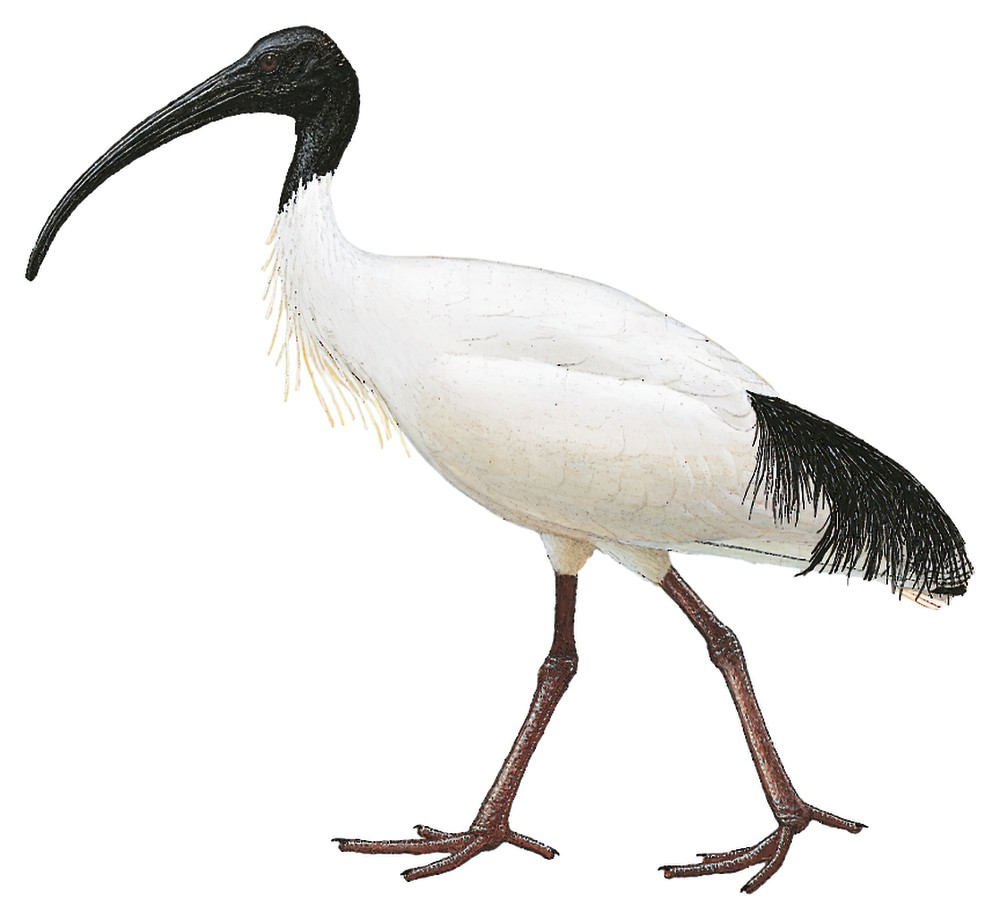Australian Ibis / Threskiornis molucca

Australian Ibis
SCI Name:
Protonym: Ibis molucca Règne Anim. ed. 2 ed. 2, 1 p.520,note
Taxonomy: Pelecaniformes / Threskiornithidae / Threskiornis
Taxonomy Code: ausibi1
Type Locality: Moluccas.
Author: Cuvier
Publish Year: 1829
IUCN Status: Least Concern
DEFINITIONS
THRESKIORNIS
(Threskiornithidae; Ϯ Sacred Ibis T. aethiopicus) Gr. θρησκεια thrēskeia religious worship < θρησκευω thrēskeuō to worship; ορνις ornis, ορνιθος ornithos bird; "Ibis, I. æthiopica, Lath. should form the type of a distinct division, to which I give the name of THRESKIORNIS (1842). T. æthiopica (Lath.), G. R. Gray" (G. Gray 1842). The Sacred Ibis was venerated by the ancient Egyptians, who, by reason of its crescent-shaped bill and bright white plumage, considered it to represent Thoth the moon god. Cabard & Chauvet 2003, relate that Thoth was also the patron of scribes, and that the long bill of the ibis represented the pens or quills with which they wrote.
Var. Thresciornis, Threschiornis, Thereschiornis, Thereshiornis, Threscornis.
Synon. Apterornis, Borbonibis, Carphibis, Ibis, Ornithaptera, Setibis.
molucca / moluccana / moluccanus / moluccarum / moluccensis / moluccus
Moluccas, a group of islands in the Dutch East Indies / Maluku provinces, Indonesia, formerly known as the Spice Is. (Arabic name Jazirat al-Muluk island of the kings).
● ex “Greater Cockatoo” of Edwards 1751, “Cacatua rubro cristata” of Brisson 1760, “Kakatoës à huppe rouge” of d’Aubenton 1765-1781, pl. 498, and “Great red-crested Cockatoo” of Latham 1781 (Cacatua).
● ex “Gros-bec des Moluques” of Brisson 1760 (Lonchura).
● ex “Psittacus humeris luteo-maculatis” of Brisson 1760, “Lori des Moluques” of d’Aubenton 1765-1781, pl. 216, “Lori Noira” of de Buffon 1770-1783, and “Scarlet Lori” of Edwards 1743-1751, and Latham 1781 (syn. Lorius garrulus).
● Bouro I. (= Buru); ex “Polochion” of de Buffon 1770-1783, and “Molucca Bee-eater” of Latham 1782: “It is called Polochion*, from its imitating the sound of that word as its common and perpetual note ...*This, in the language of those islanders, signifies, kiss us” (Philemon).
● Erroneous TL. Moluccas (= Malacca); ex “Petit pic des Moluques” of d’Aubenton 1765-1781, pl. 748, fig. 2, “Petit épeiche brun des Moluques” of de Buffon 1770-1783, and “Brown Woodpecker” of Latham 1782 (Picoides).
● Erroneous TL. Moluccas (= Malacca); ex “Merle des Moluques” of d’Aubenton 1765-1781, pl. 257 (Pitta).
● Erroneous TL. Amboina (= Botany Bay, New Holland); ex “Perruche des Moluques” of d’Aubenton 1765-1781, pl. 743, and “Orange-breasted Parrot” of Latham 1781 (Trichoglossus).
SUBSPECIES
Australian Ibis (molucca)
SCI Name: Threskiornis molucca molucca
molucca / moluccana / moluccanus / moluccarum / moluccensis / moluccus
Moluccas, a group of islands in the Dutch East Indies / Maluku provinces, Indonesia, formerly known as the Spice Is. (Arabic name Jazirat al-Muluk island of the kings).
● ex “Greater Cockatoo” of Edwards 1751, “Cacatua rubro cristata” of Brisson 1760, “Kakatoës à huppe rouge” of d’Aubenton 1765-1781, pl. 498, and “Great red-crested Cockatoo” of Latham 1781 (Cacatua).
● ex “Gros-bec des Moluques” of Brisson 1760 (Lonchura).
● ex “Psittacus humeris luteo-maculatis” of Brisson 1760, “Lori des Moluques” of d’Aubenton 1765-1781, pl. 216, “Lori Noira” of de Buffon 1770-1783, and “Scarlet Lori” of Edwards 1743-1751, and Latham 1781 (syn. Lorius garrulus).
● Bouro I. (= Buru); ex “Polochion” of de Buffon 1770-1783, and “Molucca Bee-eater” of Latham 1782: “It is called Polochion*, from its imitating the sound of that word as its common and perpetual note ...*This, in the language of those islanders, signifies, kiss us” (Philemon).
● Erroneous TL. Moluccas (= Malacca); ex “Petit pic des Moluques” of d’Aubenton 1765-1781, pl. 748, fig. 2, “Petit épeiche brun des Moluques” of de Buffon 1770-1783, and “Brown Woodpecker” of Latham 1782 (Picoides).
● Erroneous TL. Moluccas (= Malacca); ex “Merle des Moluques” of d’Aubenton 1765-1781, pl. 257 (Pitta).
● Erroneous TL. Amboina (= Botany Bay, New Holland); ex “Perruche des Moluques” of d’Aubenton 1765-1781, pl. 743, and “Orange-breasted Parrot” of Latham 1781 (Trichoglossus).
Australian Ibis (pygmaeus)
SCI Name: Threskiornis molucca pygmaeus
pygmaea / pygmaeum / pygmaeus / pygmea / pygmeum / pygmeus
L. pygmaeus pygmy < Gr. πυγμαιος pugmaios pygmy, of the size of a fist < πυγμη pugmē fist.
● ex “Flat-billed Auk” of Latham 1785, and “Pigmy Auk” of Pennant 1785 (Aethia).
● ex “Pygmy Parrakeet” of Latham 1781 (syn. Charmosyna palmarum).
● “73. PLATALEA. ... pygmea. 3. P. corpore supra fusco, subtus albo. Mus. Ad. Fr. 2. p. . . Habitat Surinami. Magnitudo Passeris.” (Linnaeus 1758) (Calidris).
● ex "Pygmy Curlew" of Pennant 1773, and Latham 1785 (syn. Calidris ferruginea).
● ex “Petit Gobe-mouche tacheté de Cayenne” of d’Aubenton 1765-1781, pl. 831, fig. 2, “Gobe-moucheron” of de Buffon 1770-1783, and “Dwarf Fly-catcher” of Latham 1783 (syn. Myrmotherula brachyura).
UPPERCASE: current genus
Uppercase first letter: generic synonym
● and ● See: generic homonyms
lowercase: species and subspecies
●: early names, variants, mispellings
‡: extinct
†: type species
Gr.: ancient Greek
L.: Latin
<: derived from
syn: synonym of
/: separates historical and modern geographic names
ex: based on
TL: type locality
OD: original diagnosis (genus) or original description (species)












